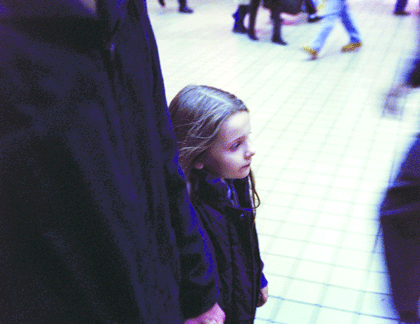Lodge Kerrigan’s latest film about life on the margins pulls its punch
Mental illness is a subject whose cinematic treatment is fraught with peril. Like terminal disease, it’s often used by actors as an excuse for a showy, Oscar-baiting performance. As it happens, “Keane” is an extremely actor-centric film about a man on the edge of his sanity, but it avoids that trap.
Damian Lewis’ turn as the title character is remarkably nuanced, offering surprises at every turn. Lodge Kerrigan’s direction reinvents neo-realist grit for contemporary America. Yet, for all the craft that went into it, “Keane” winds up a bit unsatisfying.
William Keane (Lewis) wanders around the Port Authority bus terminal in search of his six-year-old daughter. She’s been missing for months, but he thinks he still has some chance of finding her. Living off federal disability checks, he repeatedly returns to the scene of her abduction, spending his days revisiting the crime and his nights drinking, snorting coke, and having anonymous sex in nightclub bathrooms.
Keane stays at a motel in New Jersey and befriends Lynn (Amy Ryan), a poor young woman caring for a seven-year-old daughter, Kira (Abigail Breslin), and trying to reconnect with Kira’s father, who lives in Albany. Growing to trust Keane, Lynn lets him pick Kira up after school.
There’s one major thread running through Kerrigan’s slim body of work––an identification with marginalized people. Perhaps some of this stems from his own difficulty sustaining a career as a filmmaker, having made only three films in the past 11 years. His debut, “Clean, Shaven,” focused on a schizophrenic man. His excellent second film, “Claire Dolan,” was a very original portrait of a prostitute, brilliantly played by the late Katrin Cartlidge. Dolan is no happy hooker with a heart of gold, but neither is she a degraded victim in need of a man to rescue her.
Like “Claire Dolan,” “Keane” is a film about the urban environment, although their two visions of New York are utterly different. In “Keane,” the city feels hot and bursting with life, but in “Claire Dolan,” it’s a politely oppressive grid of sterile, geometrically arranged metal and glass. The first half hour of “Keane” replicates New York life at its most grating. All of Keane’s demons find outward projection here. This portion of the film is so convincing that I wouldn’t be surprised to learn that the scenes of Keane querying passing strangers about his daughter and washing himself in a public restroom were shot with a hidden camera and real bystanders.
Lewis’ manner and body language change on the drop of a dime. The actor thoroughly integrates himself into his character. Initially, Keane’s behavior is frightening; his eyes are as menacing as Charles Manson’s. Without ever quite breaking down entirely, he always seems to be on the verge of doing so. However, he’s in more danger of harming himself than anyone else, as the final third of “Keane” suggests. Even then, there are times when he alternates between a benign, paternal mood and fits of paranoia.
In an interview with Cinema Scope magazine, Kerrigan complained that the media demonizes mentally ill people, but “Keane’”s narrative is propelled by the possibility that he might harm Kira. While Lewis’ performance is nearly flawless, he’s let down by a script that fills Keane’s mutterings with back-story. At one point, he even recites his entire family history to himself. Feeling like screenwriter’s devices, these moments destroy Lewis and Kerrigan’s carefully constructed illusion of reality.
Kerrigan and cinematographer John Foster rely on a handheld camera, which remains quite close to Lewis. Every cut is a jump cut, usually a jarring one. There’s no extraneous score––we only hear music when the characters within a scene play it. Although they’re exaggerated, all these techniques contribute to a documentary feel. Nevertheless, the contrivances of “Keane” become obvious shortly before its finale.
In the late ‘90s, a common theme emerged in arthouse-lite films made around the world––bitter middle-aged men and women finding redemption through taking care of children, as in Jan Sverak’s “Kolya” and Walter Salles’ “Central Station.” Terry Zwigoff rightfully mocked this genre in “Bad Santa.” However, “Keane” adopts it with few reservations. Ultimately, it recalls the flaws of one of Neo-realism’s main architects, Vittorio de Sica. An abrasive surface is made palatable by an underpinning of reassuring sentimentality.
It says something about Kerrigan’s strengths––and, possibly, his true interests––that the film is far more compelling laying out the unpleasant details of Keane’s life than searching for a way out of them. He’s willing to make the audience uncomfortable but not without an ending dose of uplift more worthy of a Tom Hanks movie.
gaycitynews.com



































